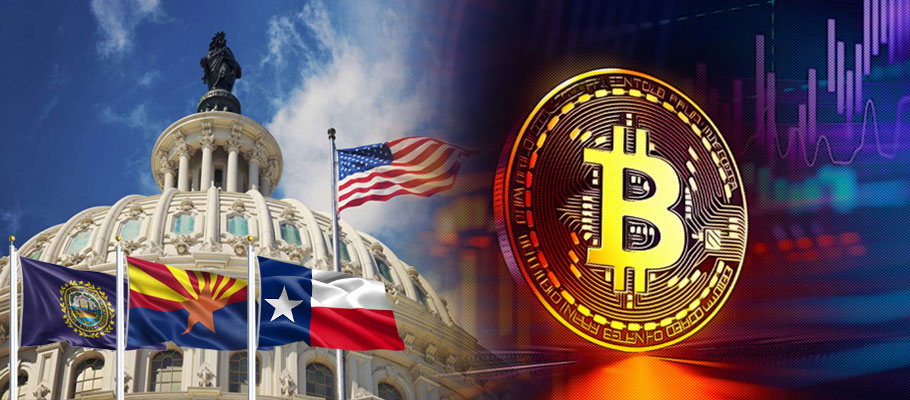
Published: July 23rd, 2025
As corporate whales continue to stockpile Bitcoin and the US president touts the creation of a federal crypto hoard, state governments across America are rushing to enact Bitcoin reserves of their own.
Bills have been passed in three states – Texas, New Hampshire, and Arizona, while the Bitcoin Reserve Monitor newsletter says there are currently 17 similar bills under consideration in other US states.
States with pending BTC reserve legislation include Alabama, Georgia, Florida, Illinois, Idaho, Kentucky, Kansas, Missouri, Michigan, Maryland, Maine, North Carolina, New Mexico, Oklahoma, Ohio, Rhode Island, and West Virginia.
The scope of legislation and legal definitions of "Bitcoin reserve" differ from state to state. While some bills are designed to allow state treasuries to buy BTC on the open market, others would only enable retention of digital assets seized through enforcement actions, similar to legal moves made by Germany in 2022.
Some of the proposed laws would free states to hold other coins like ETH and SOL as well. However market capitalization thresholds would have to be altered first. In practical terms, Bitcoin is the only digital asset that could meet the criteria for reserve status.
At least five states have rejected similar initiatives, seeing them fall short due to political resistance and financial concerns. Montana lawmakers voted down a law which would have allowed the state to keep up to $50 million in a reserve combination encompassing crypto, stablecoins, and precious metals. Similar efforts in North Dakota, Pennsylvania, and Wyoming suffered a similar fate.
South Dakota also tried and failed. A BTC reserve proposal would have set aside 10% of state funds for Bitcoin investments. The bill was effectively killed when the House Commerce and Energy Committee voted to defer it indefinitely.
In Utah, a more ambitious blockchain bill was enacted in March, but legislators removed provisions that would have set the stage for a Bitcoin reserve.
The biggest political booster for BTC's reserve status in the US is President Donald Trump.
On March 2nd, 2025, he took to his Truth social media platform and declared he would move forward with plans to set up a US crypto reserve, traders reacted with skepticism. Prices of the four coins he mentioned rose slightly on the news, but only briefly.
When that mild uptick in demand died down, markets were left with more questions than answers.
Creating a national strategic currency reserve isn't something that can be declared and executed in a day. The process is complex, lengthy, and expensive. Once the enabling legislation passes, actualizing it requires multiple approvals and oversight from numerous state bodies. A management infrastructure has to be created, and regulatory frameworks established.
And that's before the technical demands of cryptocurrencies have to be grappled with.
Regardless of potential barriers, the Trump administration seems determined to make it happen. In July 2024, then-candidate Trump told attendees at a Bitcoin Conference in Tennessee that he would create a "Strategic National Bitcoin reserve" if he becomes president again in 2025.
The day after his inauguration, Trump signed an Executive Order (EO) titled “Strengthening American Leadership in Digital Financial Technology.” The EO made provisions to position the US as a global leader in digital asset management and services. The order also referenced the future creation of a US digital asset ‘stockpile’.
Then in March he announced that a previously-announced Presidential Working Group on Digital Asset Markets would take the first steps toward building a strategic US cryptocurrency reserve. Coins included in the initial buildup include Cardano (ADA), Solana (SOL), and Ripple (XRP).
Later that month he signed an Executive Order formally establishing America's first Strategic Bitcoin Reserve. It will consist of Bitcoin-only assets and sit alongside the previously announced Digital Asset Stockpile, which will now include Ether and altcoins like XRP, Solana, and Cardano.
White House crypto czar David Sacks said the reserves would be funded without taxpayer money. Cash will come from asset forfeiture related to criminal prosecutions and civil lawsuits.
Sacks added that the crypto holdings will be held in the reserve long-term and treated as a store of value, with no plans to trade or sell them.
The Pound to Euro exchange rate rose above 1.21 on Tuesday, 12th November, the highest level reached since March of 2022.
The gains came on the heels of a Euro selloff sparked by investor worries about the collapse of Germany's coalition government and concerns that the Eurozone will be exposed to policy risks arising from Donald Trump's election win.
An analyst note from MUFG's FX strategy unit said that ‘America is Europe's number one trading partner and Trump 2.0 will likely bring higher tariffs on European imports into the US’
GBP/EUR leapt to a new multi-month high of 1.2104 on Tuesday, while EUR/USD started the new week by dipping 0.54 per cent, nearing 1.0648, its lowest level since April 2024.
At time of writing GBP/EUR had pulled back slightly from its Tuesday high, suggesting that some technical resistance might be clustered near the 1.21 level, which MUFG says could be an argument for near-term consolidative trade.
The main price dynamic in the GBP/EUR pair look to be EUR weakness, which the bank's analysts say will be vulnerable to the ‘Trump trade’ for the foreseeable future.
Julia Jessop, an economist with IEA, told Bloomberg that ‘Eurozone countries are arguably amongst the most vulnerable to new US tariffs and the reshoring of manufacturing and procurement.’
EUR came under new pressure on Tuesday thanks to the appointment of Marco Rubio as Secretary of State, a politician with a track record of statements harshly criticizing Chinese trade policy.